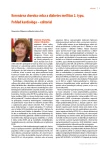Diabetes mellitus and arrhythmias
Authors:
Gabriela Kaliská
Authors place of work:
Stredoslovenský ústav srdcových a cievnych chorôb, Banská Bystrica, primárka MUDr. Gabriela Kaliská, CSc.
Published in the journal:
Forum Diab 2015; 4(1): 41-44
Category:
Hlavná téma
Summary
Type 2 diabetes mellitus (T2DM) is considered to be an important risk factor of cardiovascular disease and is known as equivalent of coronary artery disease. This fact is well-known by clinicians and is involved in management of diabetic patients. T2DM is associated with higher incidence of arrhythmias which have pathophysiologic connection to T2DM, its complications and management. The most frequent arrhythmias are atrial fibrillation (AF), sudden cardiac death and bradycardia. AF is the most common atrial arrhythmia. T2DM is an independent risk factor of thromboembolism, especially ischemic stroke, in patients with AF. Association of T2DM with AF increases morbidity, mortality, deteriorates quality of life, prolongs hospitalization and increases economic burden. This article focuses on differences between arrhythmias in diabetic patients and non-diabetic patients.
Key words:
arrhythmias – cardiovascular disease – diabetes mellitus
Zdroje
1. Gerstein HC, Miller ME, Byington RP et al. Action to Control Cardiovascular Risk in Diabetes Study Group. Effects of intensive glucose lowering in type 2 diabetes. N Engl J Med 2008; 358(24): 2545–2559.
2. Marques JL, George E, Peacey SR et al. Altered ventricular repolarization during hypoglycaemia in patients with diabetes. Diabet Med 1997, 14(8): 648–654.
3. Chow EYK, Bernjak , Williams S et al. Effect of low glucose on risk of arrhythmia in Type 2 diabetic patients with cardiovascular risk. Poster. Heart Rhythm Congress 2012.
4. Clark AL, Best CJ, Simon J et al. Even Silent Hypoglycemia Induces Cardiac Arrhythmias. Diabetes 2014; 63(5): 1457–1459.
5. Kahn SE, Haffner SM, Heise MA et al. ADOPT Study Group. Glycemic durability of rosiglitazone, metformin, or glyburide monotherapy. N Engl J Med. 2006; 355(23): 2427–2443.
6.Lin Y, Li H, Lan X, at al. Mechanism of and Therapeutic Strategy for Atrial Fibrillation Associated with Diabetes Mellitus. ScientificWorldJournal. 2013; 2013: 209428. .Dostupné z DOI: <http://dx.doi.org/10.1155/2013/209428>.
7. Aksnes TA, Schmieder RE, Kjeldsen SE et al. Impact of new-onset diabetes mellitus on development of atrial fibrillation and heart failure in high-risk hypertension (from the VALUE Trial). Am J Cardiol 2008; 101(5): 634–638.
8. Schnabel RB, Sullivan LM, Levy D et al. Development of a risk score for atrial fibrillation (Framingham Heart Study): a community-based cohort study. Lancet. 2009; 373(9665): 739–745.
9. Nichols GA, Reinier K, Chugh SS. Independent contribution of diabetes to increased prevalence and incidence of atrial fibrillation. Diabetes Care. 2009; 32(10): 1851–1856.
10. Camm AJ, Lip GYH, De Caterina R et al. 2012 focused update of the ESC Guidelines for the management of atrial fibrillation An update of the 2010 ESC Guidelines for the management of atrial fibrillation. Eur Heart J 2012; 33(21): 2719–2747.
11. Balkau B, Jouven X, Ducimetiere P et al. Diabetes as a risk factor for sudden death. Lancet 1999; 354(9194): 1968–1969.
12. El-Atat FA, McFarlane SI, Sowers JR et al. Sudden cardiac death in patients with diabetes. Curr Diab Rep 2004; 4(3):187–193.
13. Junttila MJ, MD,Barthel P, MD,Myerburg et al. Sudden cardiac death after myocardial infarction in patients with type 2 diabetes. Heart Rhythm 2010; 7(10): 1396–1403.
14. Jouven X, Lemaitre RN, Rea TD et al. Diabetes, glucose level and risk of sudden cardiac death. Eur Heart J 2005; 26(20): 2142–2147.
15. Veglio M, Chinaglia A, Cavallo-Perin P. QT interval, cardiovascular risk factors and risk of death in diabetes. J Endocrinol Invest 2004; 27(2): 175–181.
16. Jennifer D, Smith, Pharm D. Diabetes and Sudden Cardiac Death. US Pharmacist 2013; 38(2): 38–42.
17. Gill GV, Woodward A, Casson IF et al. Cardiac arrhythmia and nocturnal hypoglycaemia in type 1 diabetes: the ’dead in bed’ syndrome revisited. Diabetologia 2009; 52(1): 42–45.
18. Fishman GI, Chugh SS, DiMarco JP et al. Sudden cardiac death prediction and prevention: report from a National Heart, Lung, and Blood Institute and Heart Rhythm Society Workshop. Circulation 2010; 122(22): 2335–2348.
19. Das MK, Zipes DP. Antiarrhythmic and nonantiarrhythmic drugs for sudden cardiac death prevention. J Cardiovasc Pharmacol. 2010; 55(5):438–449.
20. Zipes DP, Wellens HJ. Sudden cardiac death. Circulation 1998; 98(21): 2334–2351.
21. Hatala R, Kaliská G, Margitfalvi P et al. Odporúčania pre implantácie ICD v podmienkach klinickej praxe v Slovenskej republike. Odborno-metodický dokument vypracovaný kolektívom autorov z poverenia Slovenskej asociácie srdcových arytmií (SASA) a Pracovnej skupiny pre arytmie a kardiostimuláciu Slovenskej kardiologickej spoločnosti (SKS). Kardiológia pre prax 2007; 5(S1): 2–7.
22. Reno CM, Daphna-Iken D, Chen YS et al. Severe hypoglycemia-induced lethal cardiac arrhythmias are mediated by sympathoadrenal activation. Diabetes 2013; 62(10):3570–3581.
Štítky
Diabetologie Endokrinologie Interní lékařstvíČlánek vyšel v časopise
Forum Diabetologicum

2015 Číslo 1
- Není statin jako statin aneb praktický přehled rozdílů jednotlivých molekul
- MINISERIÁL: Když ženám stoupá tlak...
- Primární prevence osteoporózy v kostce
- MUDr. Lenka Klimešová: Multioborová vizita může být klíčem k efektivnější perioperační léčbě chronické bolesti
Nejčtenější v tomto čísle
- Klinická diagnostika stabilnej koronárnej choroby srdca
- Význam ambulantného monitorovania krvného tlaku a ambulantného monitorovania EKG u pacientov s koronárnou chorobou srdca
- Koronárna choroba srdca a ženy
- Diabetes mellitus a arytmie
